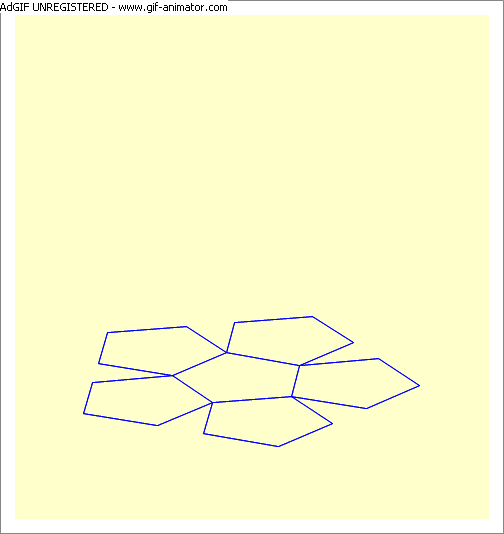Constructing the Dodecahedron

A construction of a regular dodecahedron is shown in the attached animation. If the edge length is 10 units, what is the altitude of the dodecahedron ? i.e. what the distance between two opposing faces ? (Correct to two decimal places)
The answer is 22.27.
This section requires Javascript.
You are seeing this because something didn't load right. We suggest you, (a) try
refreshing the page, (b) enabling javascript if it is disabled on your browser and,
finally, (c)
loading the
non-javascript version of this page
. We're sorry about the hassle.
4 solutions
Let's consider a pentagon ABCDE with "base" DC and vertex "A".
Let's call M the middle point of AE, N the middle point of AB, T the middle point of DC and H the middle point of MN.
Now we know that in a Dodecahedron the angle between 2 adiacent faces is ∠ 2 6 . 5 6 5 ∘ (from the previous problem 3-D Analytic Geometry).
At this point we can observe the fact that ( A T − A H ) ⋅ c o s ( 2 6 . 5 6 5 ) gives half of the height of the dodecahedron.
So A H = 5 ⋅ c o s ( 5 4 ) (angles in a regular pentagon measure 108 degrees);
A T = A D 2 − D T 2 = 2 ⋅ 1 0 2 − 2 ⋅ 1 0 2 ⋅ c o s ( 1 0 8 ) − 5 2
At the end: ( 2 ⋅ 1 0 2 − 2 ⋅ 1 0 2 ⋅ c o s ( 1 0 8 ) − 5 2 − 5 ⋅ c o s ( 5 4 ) ) ⋅ c o s ( 2 6 . 5 6 5 ) ⋅ 2 = 2 2 . 2 7 0 3 3 7
Did the same way, Upvoted !
In general, the distance between the opposite faces of a regular dodecahedron having edge length a is given by the general formula (for detailed analysis, go through HCR's formula for all five regular polyhedrons (platonic solids) )
4 sin 3 6 ∘ ( 3 + 5 ) a ≈ 2 . 2 2 7 0 3 2 7 2 9 a
As per given problem, the distance between the opposite faces of a regular dodecahedron having edge length 1 0 units is = 4 sin 3 6 ∘ ( 3 + 5 ) 1 0 ≈ 2 2 . 2 7 0 3 2 7 2 9 u n i t s
N [ 1 0 Subtract @@ Table [ If [ And @@ Table [ q [ [ 1 ] ] = qv , { qv , q } ] , q [ [ 1 ] ] , Nothing ] , { q , Table [ ToRadicals [ PolyhedronData [ Dodecahedron , Vertices ] [ [ v ] ] [ [ 3 ] ] ] , { f , PolyhedronData [ Dodecahedron , Faces ] } , { v , f } ] } ] ] ⟹ 2 2 . 2 7 0 3 2 7 2 8 8 2 3 2 1
2 0 8 5 + 8 5 1 1
Quick translation, Using Wolfram polyhedron data, find the top and bottom of the dodecahedron, subtract the lower z coordinate from the upper z coordinate and multiple by 10 as the edge length in the data is 1 .
Let e be the edge length. Then
e = 1 0
The height of the Dodecahedron can be written as the sum
h = h 1 + h 2
where h 1 is the height due to the rotated altitude of a pentagon.
(from base to apex) , and h 2 is the height from the other half of the Dodecahedron due to the rotate edge (that is connected to one to the two vertices of the edge about which rotation occurs)
h 1 = e ( sin 7 2 ∘ + sin ( 7 2 ∘ + 7 2 ∘ ) )
= e ( sin 7 2 ∘ + sin 1 4 4 ∘ )
and
h 2 = e s i n 7 2 ∘
Finally, the altitude of the Dodecahedron is given by
A = h sin 6 3 . 4 3 5 ∘
This angle is the angle of rotation of the pentagons from the initial relaxed planar position (see problem "3-D Analytic Geometry" )
Therefore,
A = e ( 2 sin 7 2 ∘ + sin 1 4 4 ∘ ) sin 6 3 . 4 3 5 ∘
Substituting the value of e = 1 0 gives
A = 2 2 . 2 7